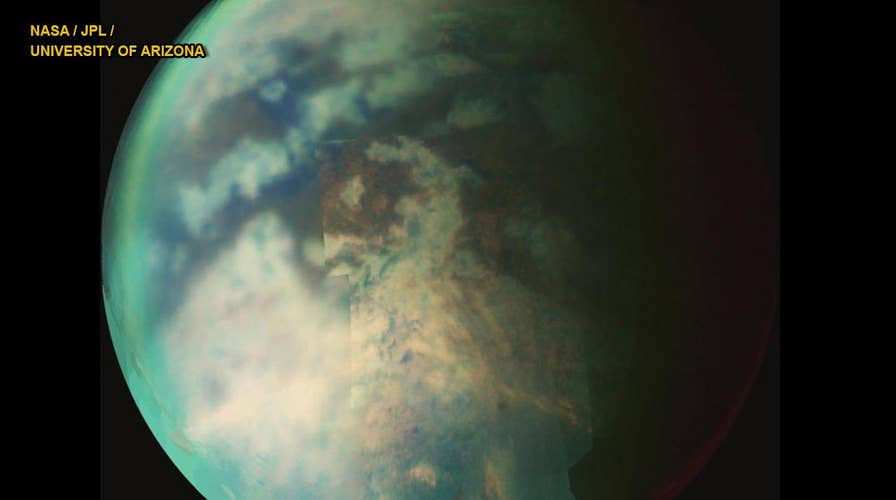Rain spotted on Saturn's moon Titan, which may be home to alien life
Saturn's moon Titan is providing another surprise to researchers, the sight of fresh rainfall.
Saturn's moon Titan, which some scientists have theorized could be the home to extraterrestrial life due to the presence of surface liquid and dust storms, is providing another surprise to researchers — the sight of fresh rainfall.
Prior to making its death plunge into the ringed planet, NASA's Cassini spacecraft was able to capture a reflective feature near the north pole of Saturn's largest moon. The image was taken in June 2016 and was published in a study in the scientific journal Geophysical Research Letters on Wednesday.
“It’s like looking at a sunlit wet sidewalk,” said Rajani Dhingra, a doctoral student in physics at the University of Idaho, in a statement. She noted that additional analysis suggested the methane rain fell on a "relatively pebble-like surface."
SCIENTISTS HAVE FOUND THE 'BUILDING BLOCKS' FOR LIFE ON SATURN'S MOON ENCELADUS
Dhingra added that the scientific community had been in search of clouds and rains on the north pole of Titan, but had yet to see any, despite what their models suggested. “People called it the curious case of missing clouds," she said.

Titan’s north pole as seen by the Cassini Visual and Infrared Mapping Spectrometer. The orange box shows the “wet sidewalk” region, what analyses suggests is evidence of changing seasons and rain on Titan’s north pole. The blue box shows the expanded region in the bottom panel. Bottom Panel: Pictured is an expanded view of Titan’s north pole. Dark blue arrows mark clouds. Red arrows mark the mirror-like reflection from a lake called Xolotlan Lacus. Pink arrows mark the “wet sidewalk”region. The black dot marks the actual north pole of Titan. Light blue arrows mark the edges of the largest north polar sea, Kraken Mare. (Credit: NASA/JPL/University of Arizona/University of Idaho)
The image covers approximately 43,330 square miles (roughly half the size of the Great Lakes) on Titan and the researchers noted that the glistening rainfall disappeared quickly, which likely means it was made up of methane rain, according to the study's abstract.
At 50 percent larger than Earth's Moon, Titan is the second largest moon in the solar system, behind only Ganymede of Jupiter.
The rainfall signifies that summer is happening on the planet and its moon (Saturn takes 29.5 Earth years to orbit the Sun), but it was delayed. Now, Dhingra said the researchers have to "figure out what caused delay."
Dust storms
In September, dust storms were spotted on Titan for the first time ever, raising the prospect the storms could be a precursor to alien life on the celestial body.
It's possible the storms are comprised of "organic molecules" NASA said, due to the chemistry of the atmosphere. Titan's atmosphere is comprised of 98.4 percent nitrogen, 1.6 percent methane and 0.1-0.2 percent hydrogen.
SATURN'S ICY MOON ENCELADUS, A POSSIBLE HOME FOR LIFE
However, once the organic molecules get big enough, they eventually fall to Titan's surface and may play a part in the dust storms.
The prevalence of dust storms and strong winds on Titan implies that the underlying sand can be moved as well and that the "giant dunes" that cover the moon's equatorial regions are constantly changing and still active.
CLICK HERE TO GET THE FOX NEWS APP
Follow Chris Ciaccia on Twitter @Chris_Ciaccia
